Evapotranspiration
Evaporation
- Early in the growing season, water loss from the soil occurs primarily through evaporation from the soil surface.
- As the crop growth and more leaf area shades the soil, evaporation will decline as transpiration increases.
- Crop residue on the soil surface can significantly reduce the amount of water lost through evaporation by reflecting solar radiation and protecting the soil from wind.
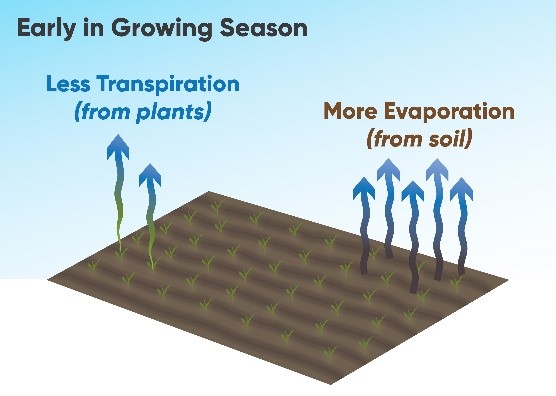
Early in the growing season, more water leaves the soil through evaporation compared to the small amount transpired by the small plants.
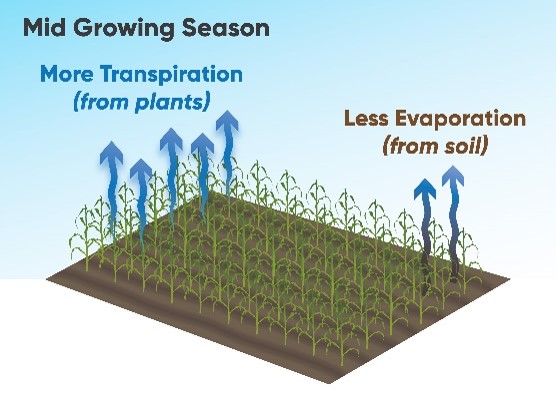
By mid-season, leaf area is much larger than the exposed soil surface and transpiration accounts for 90 to 98% of ET.
Transpiration
- In the process of transpiration, plants take up water from the soil and transport it to the leaves. Small openings in the leaves (stomata) allow water vapor to pass from the plant into the atmosphere, cooling the plant.
- The rate of transpiration depends on climatic conditions – primarily air temperature, wind, humidity, and solar radiation.
- The rate of transpiration increases with higher air temperature, solar radiation, and wind speed.
- High humidity levels reduce transpiration by decreasing the difference in water potential between the leaf airspace and the ambient air.
Corn ET During the Growing Season
- Evaporation often accounts for 20 to 30% and transpiration 70 to 80% of total ET over the course of a growing season (Kranz et al. 2008).
- Separately measuring evaporation and transpiration is difficult, so the processes are usually treated as a combined flux (ET).
- Daily ET varies greatly throughout the growing season due to day-to-day variability in weather conditions (Figure 1).
- On average, daily ET increases through the vegetative growth stages, peaks around silking, and declines through grain fill. (Table 1).
- Total ET over the course of the growing season depends on local climatic conditions and the relative maturity of the hybrid. Longer relative maturity hybrids will require more water over the course of the growing season (Figure 2).
Table 1. Average daily corn water use (ETc), water use per growth stage, and cumulative water use over the course of the growth season.
Growth Stage
|
Daily Water Use Rate (inches)
|
Water Use Per Stage (inches)
|
Cumulative Water Use (inches)
|
Emergence (VE)
|
0.08
|
0.8
|
0.8
|
4-leaf (V4)
|
0.10
|
1.8
|
2.6
|
8-leaf (V8)
|
0.18
|
2.9
|
5.5
|
12-leaf
|
0.26
|
1.8
|
7.3
|
Early tassel (R1)
|
0.32
|
3.8
|
11.1
|
Silking (R2)
|
0.35
|
4.1
|
15.2
|
Blister Kernel (R3)
|
0.32
|
1.9
|
17.1
|
Beginning Dent (R4.7)
|
0.24
|
3.8
|
20.9
|
Full Dent (R5.5)
|
0.20
|
3.8
|
24.7
|
Maturity (R6)
|
0.10
|
1.4
|
26.1
|
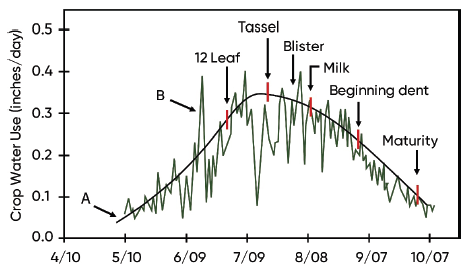
Figure 1. Long-term daily average (black line) and individual year (green line) corn water use by growth stage (Kranz et al., 2008).
- Peak water use, or ET, can often get as high as 0.35 inches per day during the early reproductive stages of growth and may even get as high as .50 inches per day on a hot windy day on the southern High Plains.
- Seasonal corn water use can range from 21 to 28 inches during the growing season, depending on the local ET rates.
- Fifty percent of the total water use of a corn crop occurs during the reproductive stages of development.
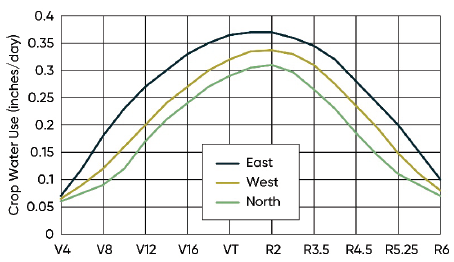
Figure 2. Average corn evapotranspiration by growth stage in different regions of the Corn Belt
Corn Rooting Depth and Water Uptake
- Well-developed root systems are essential for corn water uptake and growth.
- Root systems that are unimpeded by soil factors will generally grow down through the soil profile at a rate of 2.75 inches per leaf stage to a maximum depth of around 60 inches.
- The effective rooting depth – the depth from which the majority of water uptake occurs – is less than the total rooting depth.
- Early in the growing season, the majority of water extraction occurs in the first foot of the soil profile.
- Water extraction from the second and third foot of the profile increases substantially around the R1 stage.
- Under drought stress conditions, water extraction can increase at deeper layers as water near the top of the profile is depleted (Irmak and Rudnick, 2014).
Root Depth During Vegetative Growth
- Root development accelerates as the plant enters rapid growth beginning around V5.
- Rooting depth increases by around 2.75 inches per leaf stage during vegetative growth.
- Maximum root depth is determined by the depth of the water table.
Growth Stage
|
Rooting Depth (in)
|
V4
|
14
|
V6
|
20
|
V8
|
25
|
V10
|
31
|
V12
|
36
|
V14
|
42
|
V16
|
47
|
V18
|
53
|
V20
|
58
|
Archontoulis and Licht, 2017
Impact of Water Stress
- The impact of water stress on corn grain yields varies with crop growth stage (Figure 3).
- Corn is relativity insensitive to water deficits during early vegetative growth because water demand is relatively low.
- Plants can adapt to water stress throughout most of the vegetative period to reduce its impact on grain yield; however, corn is much more sensitive to water stress from flowering through grain fill.
- Corn hybrids vary in their ability to withstand water stress. Pioneer® brand Optimum® AQUAmax® hybrids include key native traits designed to help withstand drought conditions and protect against yield loss.
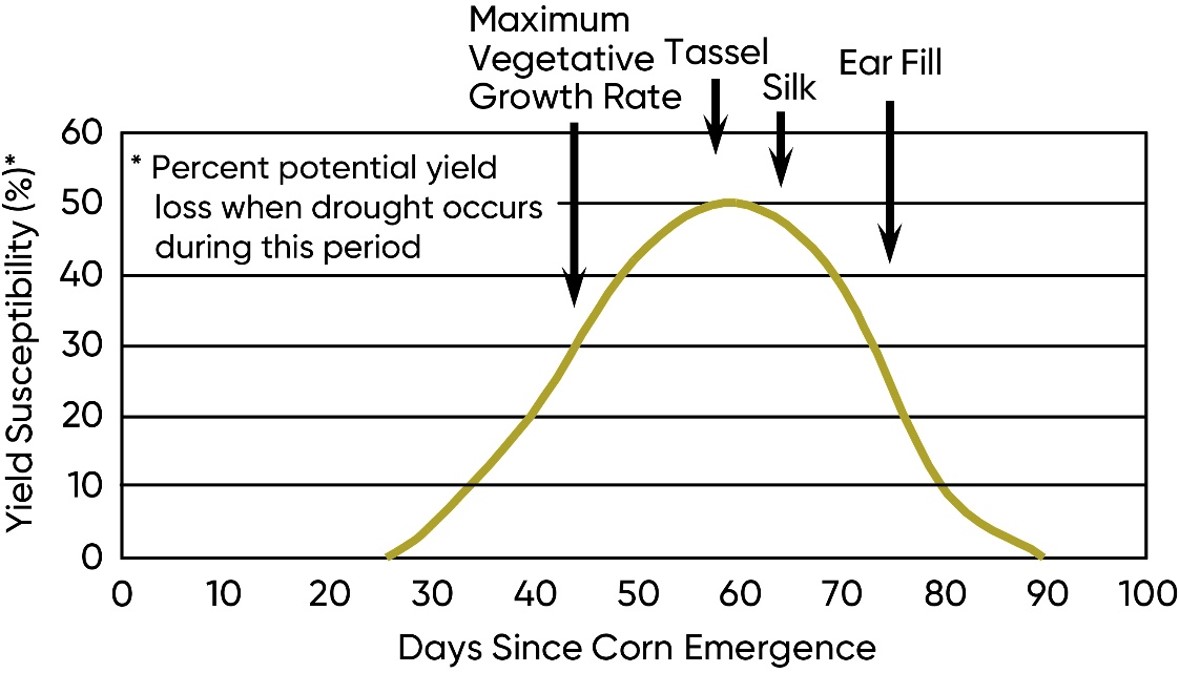
Figure 3. Yield susceptibility to water stress for corn (Sudar et al., 1981).
References
Archontoulis, S., and M. Licht. 2017. How Fast and Deep do Corn Roots Grow in Iowa? Iowa State University Extension. ICM News. https://crops.extension.iastate
.edu/cropnews/2017/06/how-fast-and-deep-do-corn-roots-grow-iowa
Irmak, S., and D. Rudnick. 2014. Corn Soil-Water Extraction and Effective Rooting Depth in a Silt-Loam Soil. NebGuide, G2245, University of Nebraska-Lincoln Extension. https://extensionpublications.unl.edu/assets/pdf/g2245.pdf
Kranz, W.L., S. Irmak, S.J. van Donk, C.D. Yonts, D.L. Martin. 2008. Irrigation Management for Corn. NebGuide, G1850, University of Nebraska-Lincoln Extension. https://extensionpublications.unl.edu/assets/pdf/g1850.pdf
Sudar, R.A., K.E. Saxton, and R.G. Spomer. 1981. A predictive model of water stress in corn and soybeans. Transactions of ASAE, 24:97-102.
Author: Dan Berning and Mark Jeschke
Vol. 13 No. 15 June 2021
The foregoing is provided for informational use only. Please contact your Pioneer sales professional for information and suggestions specific to your operation. Product performance is variable and depends on many factors such as moisture and heat stress, soil type, management practices and environmental stress as well as disease and pest pressures. Individual results may vary. Pioneer® brand products are provided subject to the terms and conditions of purchase which are part of the labeling and purchase documents. CF210611












